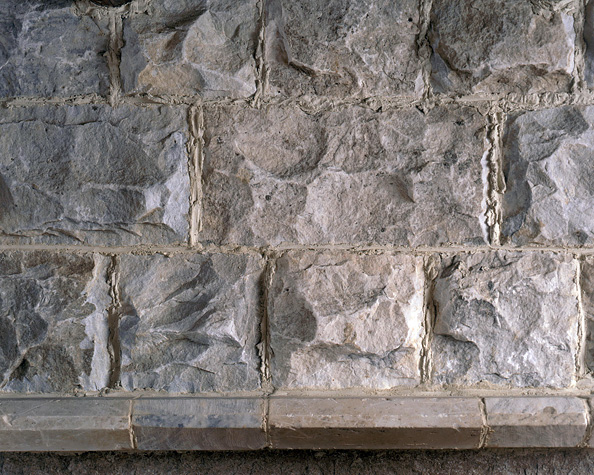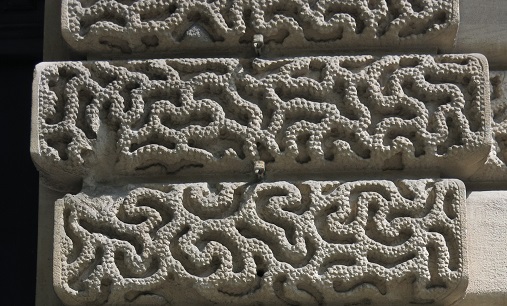Rustication
Contents |
[edit] Introduction
In classical architecture, ‘rustication’ is a type of decorative masonry that provides a purposefully rough or patterned surface for exterior masonry walls. The technique used for rustication is to cut the visible face of each individual masonry block back at the edges to a plane surface, leaving the central portion of the face projecting outwards. Rustication is typically used on the ground floor level, often as a means of contrasting visually with smoothly-finished masonry surfaces known as ashlar.
As a technique, rustication was used in ancient Greek, as well as Roman and medieval, architecture. It was later revived for the period of Italian Renaissance architecture where it can be seen on palaces such as the Pitti Palace and the Medici-Riccardi Palace, both in Florence, Italy. Inigo Jones was responsible for introducing rustication to England in the 17th century, and it became a common feature in English stonework during the 17th and 18th centuries.
There are several variations from the standard form of rustication:
[edit] Banded rustication
In this common variation, the external face of the block is smooth, but differs from ashlar in that the horizontal joints are cut back while the vertical joints are minimised. This is commonly seen on the ground level of buildings such as the Palace of Versailles or the Foreign Office on Whitehall.
[edit] Vermiculation
Vermiculation leaves the surface rough but with worm-like casts or tracks chiseled into it in different patterns. This requires a large degree of skill from a mason. Where the patterns join together to form a network the style is known as ‘reticulation’.
[edit] Prismatic rustication
Prismatic rustication involves beveling the edges of the block at an angle so that its faces rise to a ridge-like point in the centre like a prism, or to a single point like a low pyramid. This was a common feature of Baroque architecture.
[edit] Feigned rustication
Feigned rustication is an imitation style, often used to make a timber façade appear like a rusticated stone surface by cutting and sanding beveled grooves. This became a popular feature of American architecture during the 18th century.
[edit] Related articles on Designing Buildings
- Ashlar.
- Bas-relief.
- Brick.
- Blockwork.
- Classical orders in architecture.
- Concrete.
- Elements of classical columns.
- Fillet.
- Frieze.
- Kinetic facade.
- Large-scale murals.
- Masonry.
- Mortar.
- Moulding.
- Natural stone cladding.
- Pebbledash.
- Quoin.
- Rendering.
- Stone dressing.
- Strapwork.
- Stuart architecture.
- Trompe l’oeil.
Featured articles and news
RTPI leader to become new CIOB Chief Executive Officer
Dr Victoria Hills MRTPI, FICE to take over after Caroline Gumble’s departure.
Social and affordable housing, a long term plan for delivery
The “Delivering a Decade of Renewal for Social and Affordable Housing” strategy sets out future path.
A change to adoptive architecture
Effects of global weather warming on architectural detailing, material choice and human interaction.
The proposed publicly owned and backed subsidiary of Homes England, to facilitate new homes.
How big is the problem and what can we do to mitigate the effects?
Overheating guidance and tools for building designers
A number of cool guides to help with the heat.
The UK's Modern Industrial Strategy: A 10 year plan
Previous consultation criticism, current key elements and general support with some persisting reservations.
Building Safety Regulator reforms
New roles, new staff and a new fast track service pave the way for a single construction regulator.
Architectural Technologist CPDs and Communications
CIAT CPD… and how you can do it!
Cooling centres and cool spaces
Managing extreme heat in cities by directing the public to places for heat stress relief and water sources.
Winter gardens: A brief history and warm variations
Extending the season with glass in different forms and terms.
Restoring Great Yarmouth's Winter Gardens
Transforming one of the least sustainable constructions imaginable.
Construction Skills Mission Board launch sector drive
Newly formed government and industry collaboration set strategy for recruiting an additional 100,000 construction workers a year.
New Architects Code comes into effect in September 2025
ARB Architects Code of Conduct and Practice available with ongoing consultation regarding guidance.
Welsh Skills Body (Medr) launches ambitious plan
The new skills body brings together funding and regulation of tertiary education and research for the devolved nation.
Paul Gandy FCIOB announced as next CIOB President
Former Tilbury Douglas CEO takes helm.
UK Infrastructure: A 10 Year Strategy. In brief with reactions
With the National Infrastructure and Service Transformation Authority (NISTA).
























